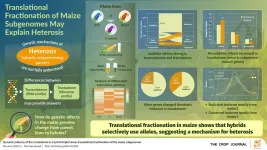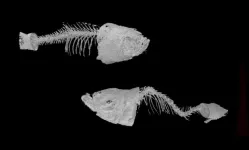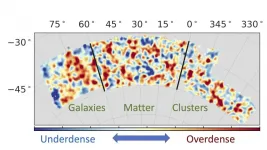(Press-News.org) The adage goes, "Two is better than one." Well, that might be true for endeavors involving human heads, but when it comes to ears, hybrid maize tends to have a superior advantage over the parental stocks in most cases. This phenomenon, called hybrid vigor or "heterosis," has been used by agriculturalists across ages to create higher-yielding, more resistant varieties of maize all over the world.
But what are the factors contributing to the increased hybrid vigor of maize? Several different genetic models have been proposed to explain heterosis in varied crops including maize, but none have hitherto been able to comprehensively unravel the mystery of heterosis.
A possible reason for this may be the complex genetic origin of the present-day maize species--Zea mays. Maize is supposed to have diverged from sorghum during an ancient speciation event, following which there was a duplication of the entire chromosomal materials or the genomic set in the ancestral stock via a process called polyploidization, giving rise to an ancestral tetraploid, or a plant with four genomic sets, i.e., double the usual number. Each genomic set in this tetraploid maize ancestor, called a subgenome, underwent dramatic breaks and fusion to eventually give rise to the current diploid genome (which bears two sets of genetic materials). During this genomic reorganization, redundant copies of genes from both subgenomes were lost through a process called fractionation.
In plants where such fractionation has been identified, including maize, there is a tendency for one subgenome to experience more gene loss than the other--a process called fractionation bias. For instance, the two subgenomes in present-day maize, termed maize1 and maize2, show differential expression of constituent genes, with maize1 typically identified as the dominant between the two.
It could be that differential expression of proteins coded by the maize subgenomes is responsible for the increased vigor of the hybrid maize lines, which are referred to as F1. However, this has not been clearly established. Until now.
Now, researchers in China have explored the transcriptome (the full complement of protein-coding mRNA molecules derived from information coded in DNA) and translatome (the actual mRNA set that gets translated to proteins in cell) of maize to identify factors that may be potentially responsible for heterosis in maize.
Using the new ribosome profiling technique, the researchers, led by Professor Lin Li of National Key Laboratory of Crop Genetic Improvement, Huazhong Agricultural University, evaluated the maize parental lines B73 and Mo17, and their F1 offspring. Their findings, published in The Crop Journal, suggest the presence of prominent subgenome bias at the translation level, especially skewed towards translated subgenome maize1 genes, which had a nonadditive effect on heterosis in F1 plants.
Furthermore, some genes switched to the dominant form in the hybrid than in the parental lines, quite surprisingly. As Prof. Li observes, "More genes switched the dominant isoforms between the F1 and the two parents than between the two parents. This observation indicates that the best gene variant is more likely to be selectively utilized in hybrids for a given environment, leading to higher efficiency of protein accumulation in the hybrids."
Moreover, the switched gene isoforms mostly belonged to subgenome maize2, while the conserved gene isoforms belonged to subgenome maize1. This knowledge, the researchers suggest, can help in selective breeding for further improving hybrid vigor.
Additionally, the researchers found evidence for additive effects of gene expression at both the transcriptome and the translatome levels in the hybrid. According to Prof. Li, "All these results are in accordance with the 'Goldilocks hypothesis,' suggesting that additive expression is advantageous for both transcriptome and translatome."
These findings suggest the potential role of asymmetric subgenome translation as an important factor contributing to heterosis in maize. These insights can provide crop breeders with effective gene manipulation tools to increase yield of not just maize, but other food crops, which might serve to address the looming food scarcity in face of the growing human population across the world.
INFORMATION:
Reference
Authors: Wanchao Zhu (a), Sijia Chen (a), Tifu Zhang (b), Jia Qian (a), Zi Luo (a), Han Zhao (b), Yirong Zhang (c), Lin Li (a)
Title of original paper: Dynamic patterns of the translatome in a hybrid triplet show translational fractionation of the maize subgenomes
Journal: The Crop Journal
DOI: 10.1016/j.cj.2021.02.002
Affiliations:
(a) National Key Laboratory of Crop Genetic Improvement, Huazhong Agricultural University, Wuhan 430070, Hubei, China
(b) Jiangsu Provincial Key Laboratory of Agrobiology, Institute of Germplasm Resources and Biotechnology, Jiangsu Academy of Agricultural Sciences, Nanjing 210014, Jiangsu, China
(c) Key Laboratory of Crop Heterosis and Utilization (MOE) and State Key Laboratory for Agrobiotechnology, Key Laboratory of Crop Genomics and Genetic Improvement (MOA), Beijing Key Laboratory of Crop Genetic Improvement, China Agricultural University, Beijing 100193, China
About Professor Lin Li
Professor Lin Li is the principal investigator of National Key Laboratory of Crop Genetic Improvement, Huazhong Agricultural University (HZAU). He obtained his Ph.D in plant genetic breeding from China Agricultural University in 2010 and joined HZAU in 2016 after his post-doctoral training in the University of Minnesota, Twin Cities. His current research area is maize germplasm and systems biology.
Pain will lessen over time
Results include longer distance and walking time
8.5 million people in U.S., 250 million worldwide, have PAD
CHICAGO --- No pain means no gain when it comes to reaping exercise benefits for people with peripheral artery disease (PAD), reports a new Northwestern Medicine study.
In people with peripheral artery disease, walking for exercise at an intensity that induces ischemic leg pain (caused by restricted blood flow) improves walking performance -- distance and length of time walking -- the study found. Walking at a slow pace that does not induce ischemic leg symptoms is no more effective than no exercise at all, the study showed.
This randomized trial is the first to show that a home-based walking exercise program ...
Washington, D.C. - April 6, 2021 - A new study has demonstrated that autism spectrum disorder is related to changes in the gut microbiome. The findings are published this week in mSystems, an open-access journal of the American Society for Microbiology.
"Longitudinally, we were able to see that within an individual, changes in the microbiome were associated with changes in behavior," said principal study investigator Catherine Lozupone, PhD, a microbiologist in the Department of Medicine, University of Colorado, Anschutz Medical Campus, Aurora, Colorado. "If we are going to understand the link between the gut microbiome and autism, we need more collaborative efforts across different regions and ...
Biophysicists from Ludwig-Maximilians-Universitaet (LMU) in Munich have shown that a phenomenon known as diffusiophoresis, which can lead to a directed particle transport, can occur in biological systems.
In order to perform their biological functions, cells must ensure that their logistical schedules are implemented smoothly, such that the necessary molecular cargoes are delivered to their intended destinations on time. Most of the known transport mechanisms in cells are based on specific interactions between the cargo to be transported and the energy-consuming motor ...
The founding chair of the Biomedical Engineering Department at the University of Houston is reporting a new deep neural network architecture that provides early diagnosis of systemic sclerosis (SSc), a rare autoimmune disease marked by hardened or fibrous skin and internal organs. The proposed network, implemented using a standard laptop computer (2.5 GHz Intel Core i7), can immediately differentiate between images of healthy skin and skin with systemic sclerosis.
"Our preliminary study, intended to show the efficacy of the proposed network architecture, holds promise in the characterization of SSc," reports Metin Akay, John S. Dunn Endowed Chair Professor of biomedical engineering. ...
WASHINGTON--Raindrops on other planets and moons are close to the size of raindrops on Earth despite having different chemical compositions and falling through vastly different atmospheres, a new study finds. The results suggest raindrops falling from clouds are surprisingly similar across a wide range of planetary conditions, which could help scientists better understand the climates and precipitation cycles of other worlds, according to the researchers.
Raindrops on Earth are made of water, but other worlds in our solar system have precipitation made of more unusual stuff. On Venus, ...
As part of an international collaboration, researchers from ELTE Eötvös Loránd University developed a new animal model to study a rare genetic disease that can lead to blindness at the age of 40-50. The new model could open up new perspectives in our understanding of this metabolic disease and will also help to identify new potential drug candidates, according to the recent study published in Frontiers in Cell and Developmental Biology.
Pseudoxanthoma elasticum (PXE) is a rare genetic disease with symptoms that usually manifest in adolescence or in early adulthood. The symptoms are caused by the appearance of hydroxyapatite crystal deposits in the subcutaneous connective tissue and retina ...
The universe is expanding at an ever-increasing rate, and while no one is sure why, researchers with the Dark Energy Survey (DES) at least had a strategy for figuring it out: They would combine measurements of the distribution of matter, galaxies and galaxy clusters to better understand what's going on.
Reaching that goal turned out to be pretty tricky, but now a team led by researchers at the Department of Energy's SLAC National Accelerator Laboratory, Stanford University and the University of Arizona have come up with a solution. Their analysis, published April 6 in Physical Review ...
Nursing mothers who receive a COVID-19 vaccine may pass protective antibodies to their babies through breast milk for at least 80 days following vaccination, suggests new research from Washington University School of Medicine in St. Louis.
"Our study showed a huge boost in antibodies against the COVID-19 virus in breast milk starting two weeks after the first shot, and this response was sustained for the course of our study, which was almost three months long," said first author Jeannie Kelly, MD, assistant professor of obstetrics and gynecology. "The antibodies levels were still high at the end of our study, so the protection likely extends even longer."
Based ...
Cells from individuals with Major Depressive Disorder (MDD) were found to have higher than expected rates of methylation at specific sites on their DNA, when compared to cells from healthy individuals without MDD, according to a study by a multidisciplinary team of UC San Francisco scientists, in collaboration with others. Methylation is a process by which DNA is chemically modified at specific sites, resulting in changes in the expression of certain genes. Methylation of particular sets of genes, called "DNA methylation clocks," typically change in predictable ways as people ...
During the early phase of the pandemic, approximately 40% of the COVID-19 literature was shared as preprints - freely available manuscripts that are shared prior to peer-review. In a new study publishing in the open access journal PLOS Biology, researchers led by Dr Jonathon Coates (Queen Mary University of London), Dr Nicholas Fraser (Leibniz Information Centre for Economics, Germany) and Dr Liam Brierley (University of Liverpool) explore the crucial role of preprint servers in hosting COVID-19 related science and how these preprints have been used to disseminate knowledge of COVID-19, leading to cultural shifts in journalistic and policy practices.
There has been a rapid and incredible scientific response to the COVID-19 pandemic, with research ...





